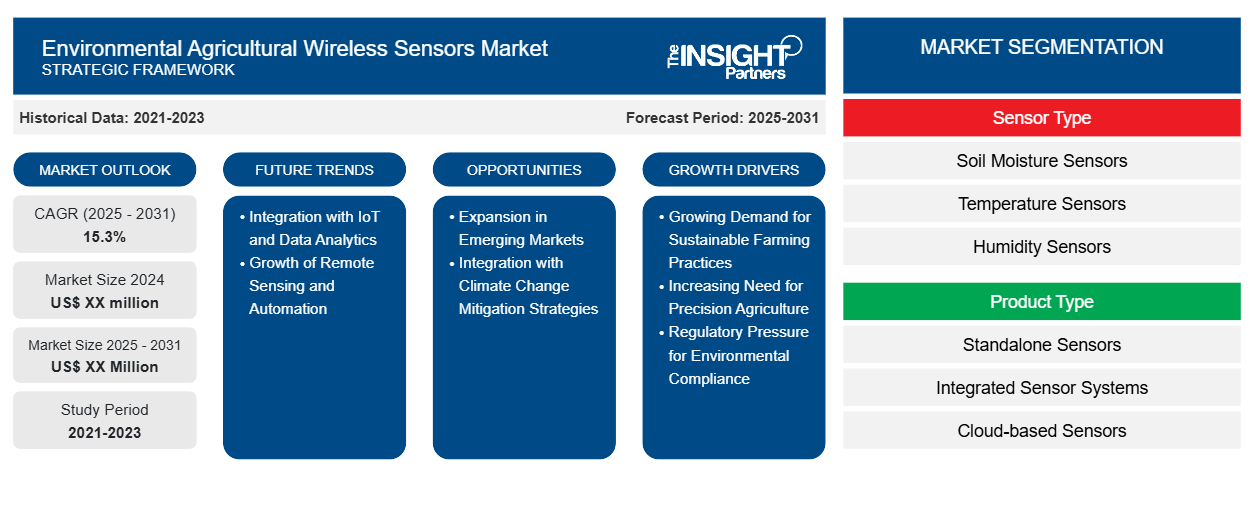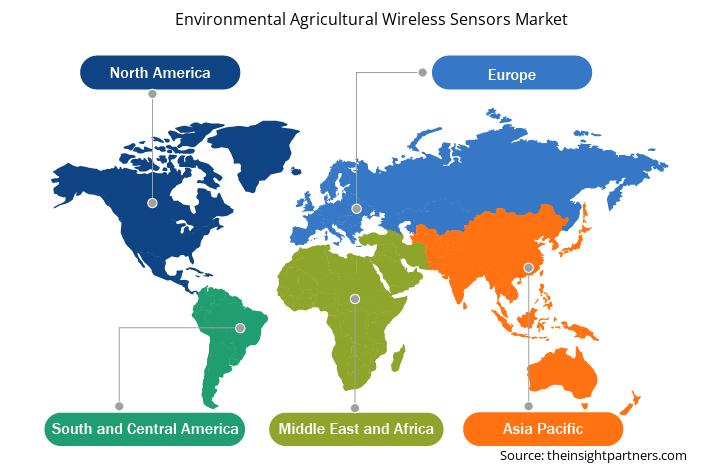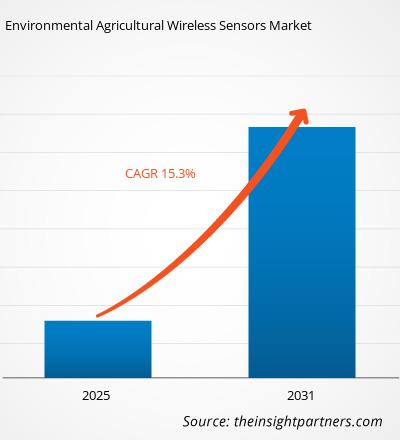预计环境农业无线传感器市场在 2025 年至 2031 年期间的复合年增长率为 15.3%,市场规模将从 2024 年的 XX 百万美元扩大到 2031 年的 XX 百万美元。
报告按传感器类型(土壤水分传感器、温度传感器、湿度传感器、营养传感器)、产品类型(独立传感器、集成传感器系统、基于云的传感器)、应用(精准农业、土壤健康监测、作物监测、天气预报)、最终用途(农业生产者、农业服务、研究机构)进行细分。全球分析进一步细分为区域和主要国家。报告以美元为单位提供上述分析和细分的价值。
报告目的
Insight Partners 发布的《环境农业无线传感器市场》报告旨在描述当前形势和未来增长、主要驱动因素、挑战和机遇。这将为各种业务利益相关者提供见解,例如:
- 技术提供商/制造商:了解不断变化的市场动态并了解潜在的增长机会,从而能够做出明智的战略决策。
- 投资者:对市场增长率、市场财务预测以及整个价值链中存在的机会进行全面的趋势分析。
- 监管机构:监管市场政策和警察活动,旨在最大限度地减少滥用行为,维护投资者的信任和信心,维护市场的完整性和稳定性。
环境农业无线传感器市场细分
传感器类型
- 土壤湿度传感器
- 温度传感器
- 湿度传感器
- 营养传感器
产品类型
- 独立传感器
- 集成传感器系统
- 基于云的传感器
应用
- 精准农业
- 土壤健康监测
- 农作物监测
- 天气预报
最终用途
- 农业生产者
- 农业服务
- 研究机构
定制此报告以满足您的需求
您可以免费定制任何报告,包括本报告的部分内容、国家级分析、Excel 数据包,以及为初创企业和大学提供优惠和折扣
环境农业无线传感器市场:战略洞察

- 获取此报告的关键市场趋势。这个免费样品将包括数据分析,从市场趋势到估计和预测。
环境农业无线传感器市场增长动力
- 对可持续农业实践的需求不断增长:随着农业部门转向更可持续的实践,无线传感器正成为优化水、肥料和农药等资源利用的重要工具。这些传感器有助于实时监测环境条件,帮助农民减少浪费并提高整体可持续性。
- 精准农业需求日益增长:随着精准农业的兴起,无线传感器在加强农作物监测和管理方面发挥着关键作用。这些传感器提供有关土壤湿度、温度、养分水平等的数据,使农民能够做出更明智的决策,以提高农作物产量,同时最大限度地减少对环境的影响。
- 环境合规监管压力:更严格的环境法规和可持续发展目标正在推动农业采用无线传感器。这些传感器可帮助农民监测和遵守环境标准,包括用水量、土壤健康和排放控制,确保更好的环境管理并降低罚款或处罚的风险。
环境农业无线传感器市场未来趋势
- 与物联网和数据分析的集成:将无线传感器与物联网 (IoT) 和高级数据分析相结合的趋势正在改变农业。通过实时收集和分析数据,农民可以优化灌溉、预测作物病害并评估土壤健康状况,从而实现更高效、更高效的农业实践。
- 遥感和自动化的发展:遥感技术(包括无人机和卫星监测)正在与无线传感器相结合,以收集详细的环境数据。这一趋势使自动化农业系统能够实时监测大面积的农业区域,从而降低劳动力成本并提高运营效率。
环境农业无线传感器市场机会
- 新兴市场的扩张:新兴市场对环境农业无线传感器的需求正在增长,农业部门正在采用现代技术。亚太、非洲和拉丁美洲等地区的国家正在投资精准农业,以提高生产力、提高可持续性并减少对环境的影响,为基于传感器的解决方案创造了机会。
- 与气候变化缓解战略相结合:随着人们对气候变化的担忧日益增加,使用无线传感器监测影响农业的环境参数(如土壤湿度、空气质量和温度波动)的机会也越来越多。这些传感器可帮助农民调整其做法以减轻气候风险并适应不断变化的天气条件,为气候智能型农业的发展提供了巨大的潜力。
环境农业无线传感器市场区域洞察
Insight Partners 的分析师已详尽解释了预测期内影响环境农业无线传感器市场的区域趋势和因素。本节还讨论了北美、欧洲、亚太地区、中东和非洲以及南美和中美洲的环境农业无线传感器市场细分和地理位置。

- 获取环境农业无线传感器市场的区域特定数据
环境农业无线传感器市场报告范围
| 报告属性 | 细节 |
|---|---|
| 2024 年的市场规模 | XX 百万美元 |
| 2031 年市场规模 | XX 百万美元 |
| 全球复合年增长率(2025 - 2031) | 15.3% |
| 史料 | 2021-2023 |
| 预测期 | 2025-2031 |
| 涵盖的领域 | 按传感器类型
|
| 覆盖地区和国家 | 北美
|
| 市场领导者和主要公司简介 |
|
环境农业无线传感器市场参与者密度:了解其对业务动态的影响
环境农业无线传感器市场正在快速增长,这得益于终端用户需求的不断增长,这些需求源于消费者偏好的不断变化、技术进步以及对产品优势的认识不断提高等因素。随着需求的增加,企业正在扩大其产品范围,进行创新以满足消费者的需求,并利用新兴趋势,从而进一步推动市场增长。
市场参与者密度是指在特定市场或行业内运营的企业或公司的分布情况。它表明在给定市场空间中,相对于其规模或总市场价值,有多少竞争对手(市场参与者)存在。
在环境农业无线传感器市场运营的主要公司有:
- Decagon 设备
- 利比利
- 泰瑞克
- 法莫比尔
- 博世
免责声明:上面列出的公司没有按照任何特定顺序排列。

- 获取环境农业无线传感器市场顶级关键参与者概述
主要卖点
- 全面覆盖:报告全面涵盖了环境农业无线传感器市场的产品、服务、类型和最终用户的分析,提供了整体概况。
- 专家分析:报告基于对行业专家和分析师的深入了解而编写。
- 最新信息:该报告涵盖了最新信息和数据趋势,确保了其与业务的相关性。
- 定制选项:此报告可以定制以满足特定客户要求并恰当地适应业务策略。
因此,环境农业无线传感器市场研究报告有助于引领解读和了解行业情景和增长前景。尽管可能存在一些合理的担忧,但本报告的总体优势往往大于劣势。
- 历史分析(2 年)、基准年、预测(7 年)及复合年增长率
- PEST和SWOT分析
- 市场规模、价值/数量 - 全球、区域、国家
- 行业和竞争格局
- Excel 数据集
近期报告
相关报告
客户评价
购买理由
- 明智的决策
- 了解市场动态
- 竞争分析
- 客户洞察
- 市场预测
- 风险规避
- 战略规划
- 投资论证
- 识别新兴市场
- 优化营销策略
- 提升运营效率
- 顺应监管趋势




















 获取免费样品 - 环境农业无线传感器市场
获取免费样品 - 环境农业无线传感器市场